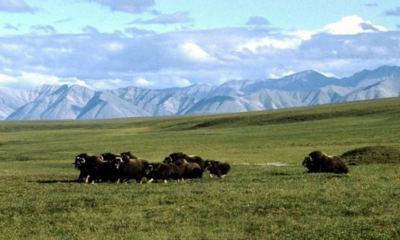Alaska
EPA requires new Alaska water quality standards for health of fish loving Alaskans – Alaska Native News

Response to a 2015 SEACC petition acknowledges Alaskans’ high fish consumption rates and disproportionate health impacts
The Environmental Protection Agency has demanded changes to the Alaska Department of Environmental Conservation’s water quality standards within six to 12 months. The current human health criteria are based on inaccurate assumptions — Alaskans eat far more than the 6.5 gram per day default rate for the general population in 1992, which means greater exposure to harmful pollutants.
“The health of Alaskans should be a top priority for the State, so new water quality standards can’t come soon enough,” said Maggie Rabb, executive director of the Southeast Alaska Conservation Council. “SEACC’s work to protect Alaska’s waters is also about protecting the people who rely on it for sustenance.”
SEACC submitted a petition in 2015 requesting revision of the “remarkably outdated” fish consumption rate used by the State of Alaska, suggesting a proposed rate of 175 grams per day by Alaskans relying on subsistence and traditional foods. The EPA had updated its general rate to 22 grams per day in 2014.
The 6.5 gram per day FCR used by the State was acknowledged as “not reflective of the actual fish consumption rate by the general or certain sub-populations of Alaskans” in a 2016 response from the then director of the Division of Water to SEACC, as cited in the EPA Administrator’s Determination dated June 5, 2024.
“The fact that Alaskans consume far more fish than most other US populations means we deserve and require more stringent water quality criteria, because higher fish consumption rate increases exposure to any contaminants that may be present in those fish,” SEACC’s petition reads.
SEACC was one of a number of entities pushing the EPA for water quality standards reflective of Alaskans’ real fish consumption rates. Another petitioner was Chickaloon Native Village. In more recent years, the Seldovia Village Tribe and Sun’aq of Kodiak conducted seafood consumption surveys for Cook Inlet and Kodiak Tribes respectively.
The EPA noted that revisions to Alaska’s human health criteria have been identified as a priority action for more than a decade, but new criteria have not been proposed for adoption.
“This Determination makes clear that new and revised HHC are necessary in Alaska to meet (Clean Water Act) requirements and that the EPA is prepared to promulgate such criteria unless the state adopts new and revised HHC that meet CWA requirements,” reads the determination, signed by Acting Assistant Administrator Bruno Pigott.
The EPA has set a timeline of 6-12 months for the changes, “given the readily available fish consumption information” and has committed to working with the state of Alaska to ensure the human health criteria are “protective of applicable designated uses, based on sound scientific rationale and responsive to the needs of Alaska’s residents.”

Alaska
Alaska Airlines adding new daily flight between Bellingham, Portland | Cascadia Daily News

Alaska Airlines is adding a daily flight between Bellingham International Airport and Portland International Airport starting next spring, the airline announced Dec. 18.
The flights will begin March 18, 2026 and will be offered during the year on the E175 jets. The announcement is part of a slew of expanded routes Alaska will begin offering in the new year across the Pacific Northwest, Wyoming and Boston.
“Anchorage and Portland are essential airports to our guests and us in our growing global network,” Kristen Amrine, vice president of revenue management and network planning for Alaska, said in the announcement. “Portland is not only a great city to visit, but we also offer convenient nonstop connections for those continuing their travel across our wide network.”
The Portland route is the first time in years the Bellingham airport has offered a flight outside of Seattle or its typical routes in California, Nevada and Arizona. In the last 10 years, Alaska and Allegiant Air ceased non-stop flights to Portland, Hawaii and Las Vegas.
Matthew Rodriguez, the aviation director for the Port of Bellingham, said Thursday his team is excited for the expanded route. The route will also allow Alaska to start data gathering to see if there’s market demand for more direct flights out of Bellingham.
The airline will be able to examine how many people from Bellingham are flying into Portland and then connecting to other flights, including popular destinations like Hawaii and San Diego.
“It’s going to help our community justify a direct flight, which, in my opinion, we have a data that already supports the direct flights, and we already had an incumbent carrier doing those direct flights,” he said. “So I don’t think it’s going to take very much additional data for Alaska to acknowledge that.”
Guests can already start booking the hour-long flight to Oregon on the Alaska Air website or app.
Intrepid airport enthusiasts have also noted Alaska is phasing out one of its nonstop flights between Bellingham and Seattle in early January.
In a statement, Alaska said the “flight adjustments are about putting more connecting flights from Bellingham through Portland to decrease some of the strain in Seattle.”
The phase-out allows for the Portland route to be brought online in time for spring travel.
Alaska is also adding a daily year-round flight between Paine Field in Everett and Portland in June.
This story was updated at 11:53 a.m. with additional comments from the Port of Bellingham.
Annie Todd is CDN’s criminal justice/enterprise reporter; reach her at annietodd@cascadiadaily.com; 360-922-3090 ext. 130.
Alaska
Alaska is reporting 18 in-custody deaths so far this year, tying a grim record

The Department of Corrections this week reported the 18th death of an inmate this year, tying the record for the highest number of annual in-custody deaths in at least the past decade.
Kane William Huff, who had been imprisoned at Goose Creek Correctional Center near Wasilla, died Dec. 11, according to a DOC statement. Huff, 46, was serving a sentence for a 2018 conviction on two counts of sexual abuse of a minor, according to online court records. DOC officials said he had been in custody since 2015.
Huff was found unresponsive in the prison’s infirmary, where he had been housed, said Department of Public Safety spokesman Austin McDaniel. Alaska State Troopers, who handle in-custody death investigations, have closed their investigation and are awaiting autopsy results from the State Medical Examiner Office, McDaniel said. Troopers don’t believe Huff died by suicide or that foul play was involved, he said.
The last time as many people died in state custody was in 2022, when a record seven inmates also died by suicide, according to a department snapshot of deaths since 2015.
The Department of Corrections began consistently keeping inmate death statistics in 2001, said spokesperson Betsy Holley. The department also posts data showing in-custody deaths since 2015. That year, 15 people died while in DOC custody.
The state’s official count for 2025 doesn’t include the death of 36-year-old William Farmer, who died in a hospital in January after he was severely beaten by his cellmate at the Anchorage Correctional Complex the month before.
An upward trend of in-custody deaths in the past several years has alarmed some prisoner rights advocates and prompted state lawmakers to ask Department of Corrections officials to address the deaths in multiple hearings this year. The department has also found itself under fire for inmate suicides.
This year, at least four inmates have died of natural or expected causes, such as disease or a medical event, while at least five have died by suicide, according to information provided by Alaska State Troopers.
Officials have also said that a Spring Creek Correctional Center prisoner died of an overdose in April.
Another inmate, 53-year-old Jeffrey Foreman, died in July after being restrained by guards after an altercation with his cellmate at the Anchorage Correctional Complex.
[Correction: An earlier version of this story incorrectly described the year the Department of Corrections started consistently keeping inmate death statistics. It was 2001, not 2015.]
Alaska
Hawaiian, Alaska airlines to use locally made biofuel | Honolulu Star-Advertiser
-

 Iowa4 days ago
Iowa4 days agoAddy Brown motivated to step up in Audi Crooks’ absence vs. UNI
-

 Washington1 week ago
Washington1 week agoLIVE UPDATES: Mudslide, road closures across Western Washington
-

 Iowa6 days ago
Iowa6 days agoHow much snow did Iowa get? See Iowa’s latest snowfall totals
-

 Maine2 days ago
Maine2 days agoElementary-aged student killed in school bus crash in southern Maine
-

 Maryland4 days ago
Maryland4 days agoFrigid temperatures to start the week in Maryland
-

 Technology1 week ago
Technology1 week agoThe Game Awards are losing their luster
-

 South Dakota5 days ago
South Dakota5 days agoNature: Snow in South Dakota
-

 Nebraska1 week ago
Nebraska1 week agoNebraska lands commitment from DL Jayden Travers adding to early Top 5 recruiting class


























